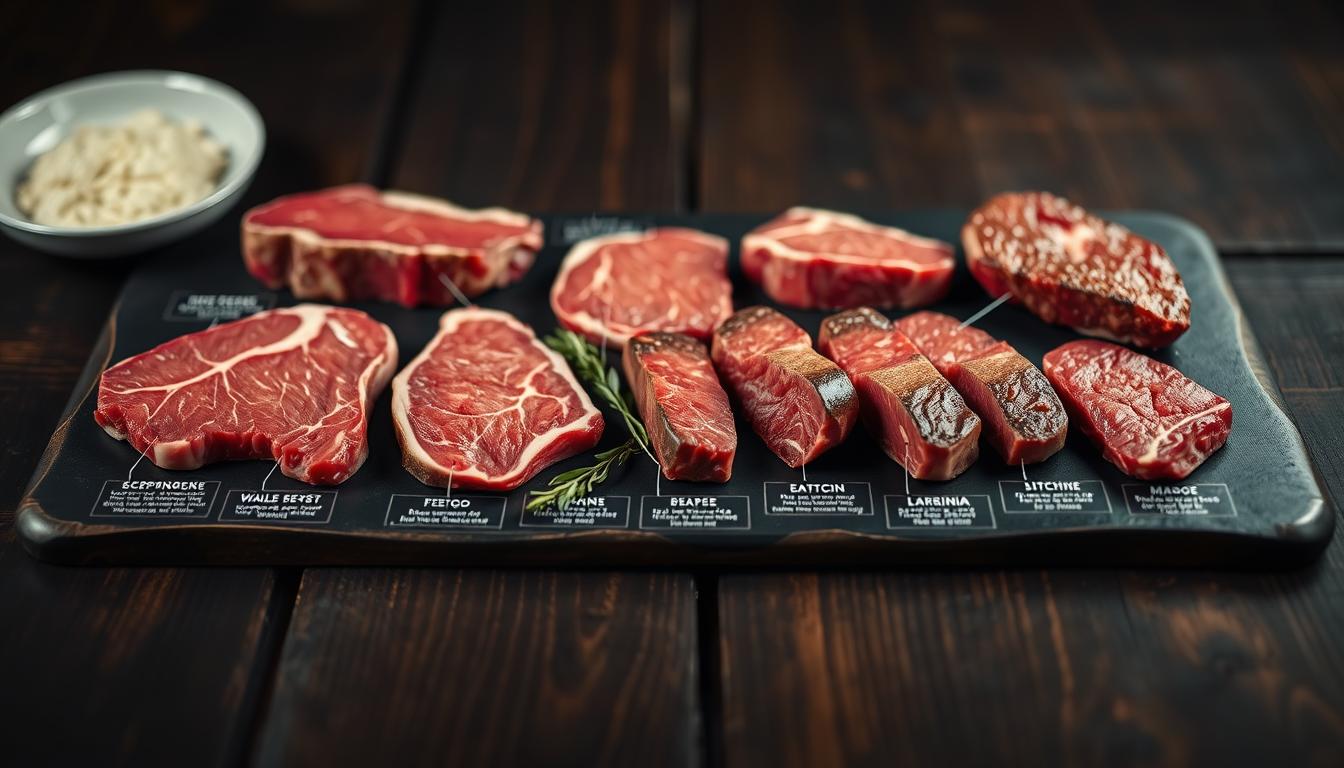Elevate Your Dining Experience: The Best Steak Cuts
Steak lovers know that the right cut makes a meal special. When you’re looking for the best steak at a restaurant, remember that not all beef is the same. Each steak cut has its own taste, tenderness, and dining experience.
Knowing about premium steak cuts is more than just picking from a menu. People who love great meat know that things like marbling and how it’s cooked matter a lot. The best steaks are a mix of skill and quality.
Choosing the perfect steak involves knowing a few things. Things like where the meat comes from, how much fat it has, and how it’s cooked are key. Some steaks are full of flavor, while others are super tender.
When you’re looking at restaurant menus, it helps to know about different steaks. You might like the rich taste of a ribeye, the lean taste of a filet mignon, or the balanced taste of a New York strip. Knowing what each cut is like helps you choose what you like best.
This guide will help you understand premium steak cuts better. You’ll learn about how steaks are graded, cooked, and taste. From affordable options to luxury like Wagyu beef, you’ll see the art and science of picking the perfect steak.
Your journey into the world of top steak cuts starts here. This guide will help you enjoy beef at its best. Get ready to make every steak meal a celebration of taste, texture, and culinary skill.
Understanding Premium Steakhouse Selections
Exploring gourmet steak dishes means knowing what makes top steaks special. The journey from the farm to your plate is complex. It shapes the quality and taste of your steak.
The Art of Steak Grading
Steak grading is a detailed method to judge meat quality. The USDA sets three main grades for beef:
- Prime Grade: The highest quality with lots of marbling
- Choice Grade: High-quality meat with some marbling
- Select Grade: Leaner meat with less marbling
From Farm to Table Journey
The journey of top steaks starts on well-managed ranches. How cattle are bred, fed, and cared for greatly affects meat quality. Sustainable farming ensures the best taste and texture.
| Farming Factor | Impact on Meat Quality |
|---|---|
| Cattle Breed | Determines meat tenderness and flavor profile |
| Diet | Influences marbling and overall taste |
| Stress Levels | Affects meat texture and juiciness |
Factors Affecting Meat Quality
Several key elements make gourmet steak dishes stand out:
- Marbling: Intramuscular fat that enhances flavor
- Age of Cattle: Younger animals typically produce more tender meat
- Aging Process: Enhances tenderness and concentrates flavor
- Muscle Usage: Less-worked muscle groups provide more tender cuts
Knowing these details helps steak lovers understand the effort behind top steaks.
Best Cut of Steak at Restaurant: A Complete Guide
Choosing the right steak at a restaurant can make your meal unforgettable. Restaurant-quality steaks bring a variety of tastes, textures, and experiences. They are more than just meat.
When looking at steak options, consider a few important things:
- Marbling quality
- Cut thickness
- Personal flavor preferences
- Desired tenderness
Different cuts of steak have unique qualities that suit different tastes. The art of choosing the perfect steak is about knowing each cut’s special traits and finding the one that suits you best.
Top steakhouses offer many premium choices for steak lovers. From tender filet mignon to rich ribeye, there’s something for everyone.
When picking the best steak, keep these tips in mind:
- Look at the meat’s color and texture
- Learn the right cooking temperatures
- Ask your server for advice
- Choose a cut that fits your taste
Whether you’re a steak expert or new to trying different cuts, picking the right steak can make your meal much better.
The Classic Ribeye: King of Marbling
Ribeye steak is the top choice for meat lovers. It’s known for its amazing marbling and rich taste. This cut is a favorite for those who want a special dining experience.
Bone-in vs Boneless Selections
Steak fans have a choice between bone-in and boneless ribeye. Bone-in steaks taste richer and are juicier. Boneless ones cook more evenly and are easier to cut.
- Bone-in advantages:
- Richer flavor development
- Enhanced moisture retention
- Traditional eating experience
- Boneless advantages:
- More uniform cooking
- Easier portion control
- Simplified preparation
Optimal Cooking Methods
To cook ribeye right, you need to know its special needs. Grilling and cast-iron searing are the best ways to cook these premium cuts.
| Cooking Method | Temperature | Recommended Technique |
|---|---|---|
| Grilling | 425-450°F | Direct high heat, 4-5 minutes per side |
| Cast-Iron Searing | 500°F | Quick sear, finish in oven |
| Reverse Searing | 275°F then 500°F | Slow cook, finish with high-heat sear |
Flavor Profile and Texture
The ribeye’s marbling gives it a unique taste. Its buttery texture and strong beef flavor are unmatched. The fat makes it tender and flavorful.
Filet Mignon: The Tender Champion
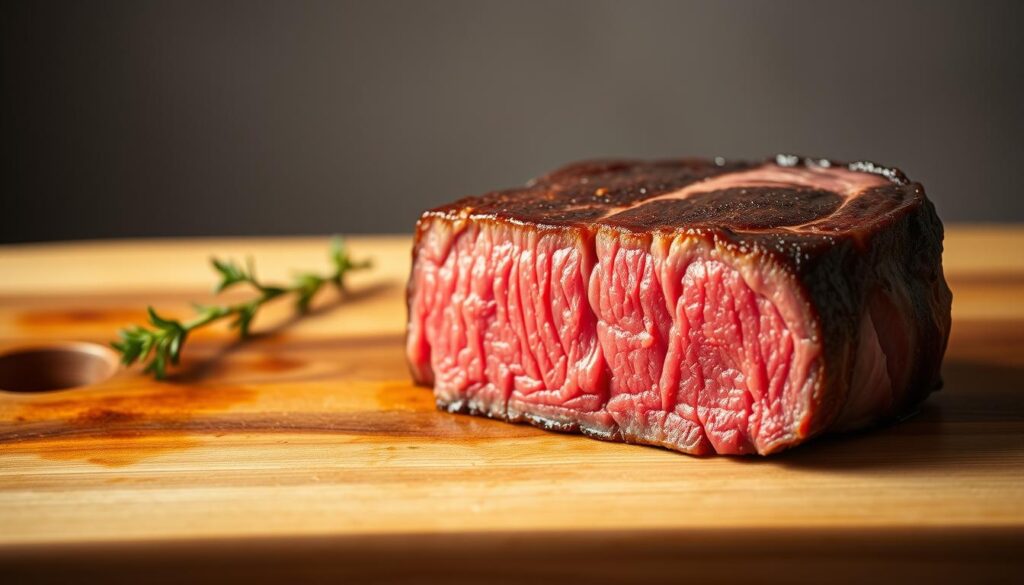
Filet mignon is the top choice among steaks, known for its tenderness and elegance. It comes from the tenderloin’s smaller end. This makes it a favorite for those who love a great steak.
Filet mignon is special because of its lean meat and mild taste. It’s a hit with those who want a fancy steak. Chefs love it for its soft texture and how well it takes on flavors.
- Extremely tender meat with minimal muscle fibers
- Lean protein with lower fat content
- Typically smaller portion size compared to other steak cuts
- Premium pricing reflecting its exceptional quality
Cooking filet mignon needs care. Culinary experts recommend cooking it to medium-rare. This keeps it juicy and tender. Restaurants often add bacon, herb butter, or rich sauces to make it even better.
- Wrapping with bacon
- Creating herb butter topping
- Serving with rich reduction sauces
| Characteristic | Filet Mignon Details |
|---|---|
| Muscle Location | Psoas major muscle |
| Average Weight | 4-8 ounces |
| Typical Price Range | $25-$50 per pound |
| Recommended Cooking Method | Grilling or pan-searing |
When picking filet mignon at a steakhouse, choose cuts that look even and have little marbling. This way, you’ll get a truly luxurious and tender steak experience.
New York Strip: The Steakhouse Standard
The New York Strip is a top choice for steak lovers. It’s known for its perfect mix of flavor and tenderness. This cut is the best of the best, giving diners a top-notch steakhouse experience.
This steak comes from the short loin of the beef. It offers a satisfying taste that meat lovers adore. Its lean meat and marbling make it rich and flavorful.
Marbling Characteristics
The New York Strip’s marbling is key to its excellence. It has:
- Moderate intramuscular fat distribution
- Fine, white streaks of fat throughout the muscle
- Consistent texture that promises juicy, flavorful bites
Preparation Techniques
Chefs use special techniques to prepare the New York Strip. The best methods are:
- High-heat searing to develop a caramelized crust
- Resting the meat to retain internal juices
- Seasoning with kosher salt and fresh cracked pepper
Wine Pairing Suggestions
Pairing the right wine with the New York Strip can enhance your meal. Recommended pairings include bold red wines like Cabernet Sauvignon or Malbec. These wines match the steak’s bold flavors, making for a memorable meal.
T-Bone and Porterhouse: Two Cuts in One
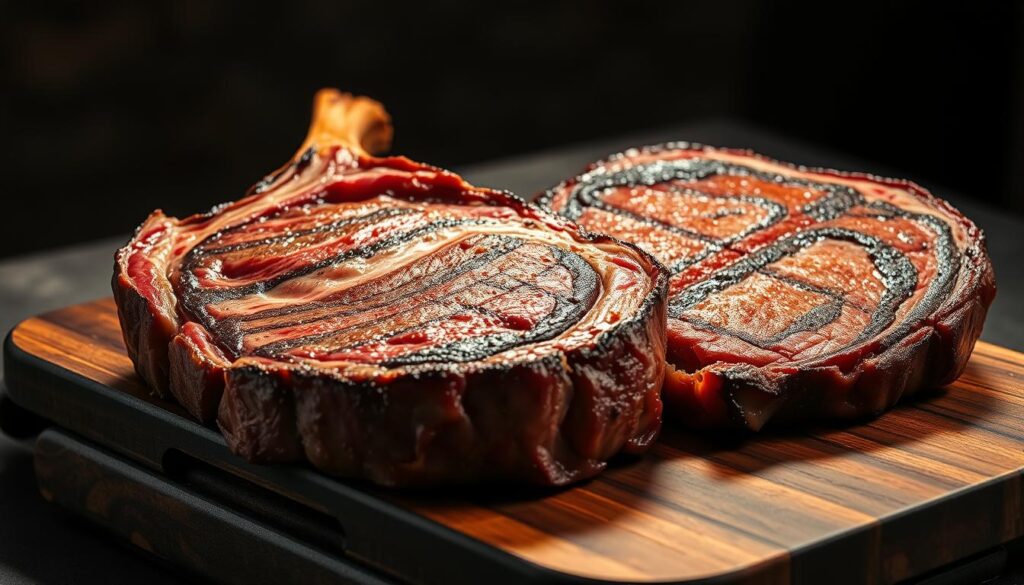
The T-Bone and Porterhouse are top picks in prime steakhouse selections. They offer a unique dining experience with two steak flavors on one plate.
The main difference is in size. Both cuts have a T-shaped bone separating the tenderloin and New York strip. The Porterhouse has a bigger tenderloin, making it more luxurious.
- T-Bone: Smaller tenderloin section
- Porterhouse: Larger tenderloin section (at least 1.25 inches wide)
- Both feature a characteristic T-shaped bone
Cooking these cuts needs careful technique. Chefs suggest a two-stage cooking method for even cooking. Reverse searing is great for a perfect crust.
These cuts are perfect for special occasions. They offer a memorable dining experience. You get to enjoy tender filet and robust strip steak together.
- Best served medium-rare
- Typically weighing 24-32 ounces
- Perfect for sharing or impressive individual meals
When choosing a T-Bone or Porterhouse, look for marbling and a bright red color. These cuts are the best in beef, giving a unique taste experience for steak lovers.
Top Sirloin: The Versatile Choice
Top sirloin is a top-notch steak that’s both tasty and tender. It’s also easy on the wallet. This makes it a great choice for those who want a high-quality steak without spending too much.
Budget-Friendly Excellence
Top sirloin is loved for its affordable price and great taste. It’s a cut that offers a rich beef flavor without the high cost of premium steaks.
- Lean muscle structure
- Rich beefy flavor profile
- Lower fat content compared to ribeye
- Consistently more affordable option
Cooking Recommendations
Cooking top sirloin right is key to avoiding toughness. Chefs suggest cooking it to medium-rare or medium. This keeps it tender and brings out the best flavors.
| Cooking Method | Temperature | Recommended Time |
|---|---|---|
| Grilling | Medium-High Heat | 4-5 minutes per side |
| Pan-Searing | High Heat | 3-4 minutes per side |
| Oven Roasting | 375°F | 20-25 minutes |
Serving Suggestions
Top sirloin goes well with many sides and sauces. Try it with roasted veggies, garlic mashed potatoes, or a light chimichurri sauce. These add to its natural taste.
- Classic steakhouse accompaniments
- Fresh herb garnishes
- Red wine reduction sauces
- Grilled vegetable medleys
Wagyu Beef: The Premium Experience
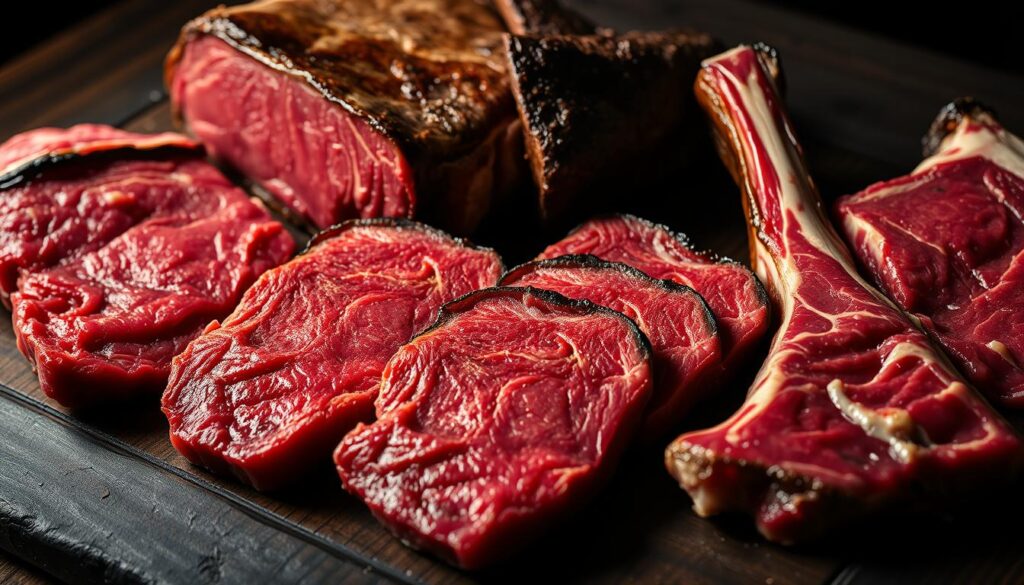
Wagyu beef is the top choice for steak lovers. It comes from Japan and is known for its amazing marbling and softness. This makes it a unique treat for your taste buds.
Wagyu beef stands out because of its special breeding and care. Farmers focus on the cattle’s diet and stress levels to improve the meat’s taste and texture. This attention to detail makes Wagyu beef a top choice for steak lovers.
- Japanese Wagyu: Considered the gold standard of beef
- American Wagyu: A crossbreed with exceptional marbling
- Grading system reflects meat’s quality levels
The grading of Wagyu beef is very detailed. The A5 rating is the highest, showing the beef’s rich marbling. This makes for a truly special eating experience.
| Wagyu Type | Marbling Score | Flavor Intensity |
|---|---|---|
| Japanese Kuroge Washu | 10-12 | Extremely Rich |
| American Wagyu | 6-9 | Rich and Smooth |
While Wagyu beef is pricier, many think it’s worth it. The marbling gives it a creamy texture and rich flavor. It turns a simple meal into a memorable culinary journey.
Dry-Aged Steaks: Enhanced Flavor Profiles
Explore the world of dry-aged steaks, a top culinary achievement. It turns top steak cuts into unforgettable meals. This method makes the finest steaks even better by aging them carefully.
Dry-aging is an old way to prepare top beef. Butchers and fancy restaurants use it to make special dishes. They control temperature, humidity, and air to create a masterpiece.
Aging Process Explained
The dry-aging process stores beef in special cold units. During this time, enzymes break down the meat. This makes the meat taste better and become tenderer.
- Moisture evaporation concentrates flavor
- Enzymatic breakdown tenderizes meat
- Protective exterior crust develops
Optimal Aging Duration
Chefs know that timing is key in dry-aging. Different cuts need different aging times:
- 14-21 days: Subtle flavor enhancement
- 30-45 days: Pronounced nutty, robust taste
- 60-90 days: Intense, complex flavor profile
Taste Characteristics
Dry-aged steaks taste amazing. They have a rich, almost cheese-like flavor. You’ll notice deeper umami notes and a tender texture that’s just right.
Even though dry-aged steaks are pricey, steak lovers see it as a special treat. They offer a unique taste experience.
Choosing the Perfect Steak Temperature
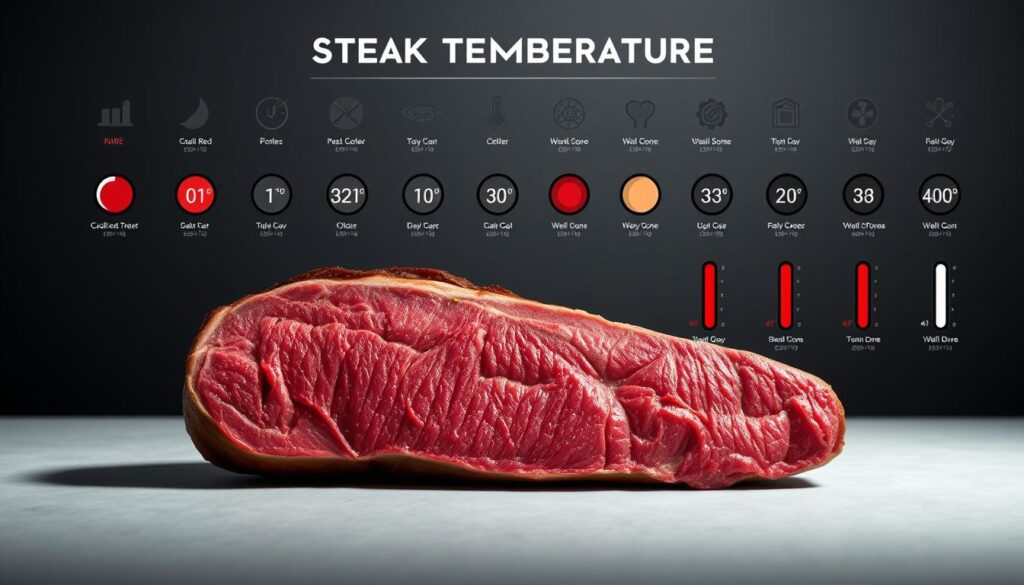
Choosing the right temperature for your steak can make a big difference. It turns a simple meal into a gourmet experience. Knowing the right steak temperature is key to a great dining experience.
Steak temperatures vary from rare to well-done, each with its own taste and texture. Top chefs in gourmet steak dishes agree that temperature greatly affects the meat’s taste and softness.
- Rare: Cool red center, soft texture (125°F)
- Medium Rare: Warm red center, most recommended by experts (135°F)
- Medium: Pink center with firmer texture (145°F)
- Medium Well: Slight pink center (150°F)
- Well Done: No pink, completely cooked through (160°F)
Most top steakhouses suggest medium rare for their steaks. It keeps the meat juicy and flavorful. Different cuts of meat react differently to heat, so choosing the right temperature is important.
When you order, tell the server exactly how you want it cooked. Say things like “pink in the middle” or give a specific temperature. This helps the server get it just right for you.
Essential Steak Accompaniments and Sides
Choosing the right steak is just the start. The perfect sides and sauces make a meal unforgettable. A great steakhouse experience is about the whole journey, not just the meat.
Classic Sauce Pairings
Sauces can really boost your steak’s taste. Chefs in top steakhouses make special sauces for each cut:
- Béarnaise: Creamy and tangy, great for tender cuts
- Peppercorn Sauce: Strong flavor, perfect for fatty steaks
- Chimichurri: Bright, herbal, cuts through fatty meats
Complementary Side Dishes
The right side dish can make your steak even better. Here are some classic choices:
- Creamy mashed potatoes
- Roasted asparagus
- Truffle mac and cheese
- Grilled seasonal vegetables
Garnish Selection
Garnishes add the final touch to your steak. Fresh herbs, crispy onion strings, or sea salt can make it look and taste better.
Choosing the right sauces, sides, and garnishes is key. They should make your steak shine, not hide it.
Restaurant Ordering Tips for Steak Enthuasiasts
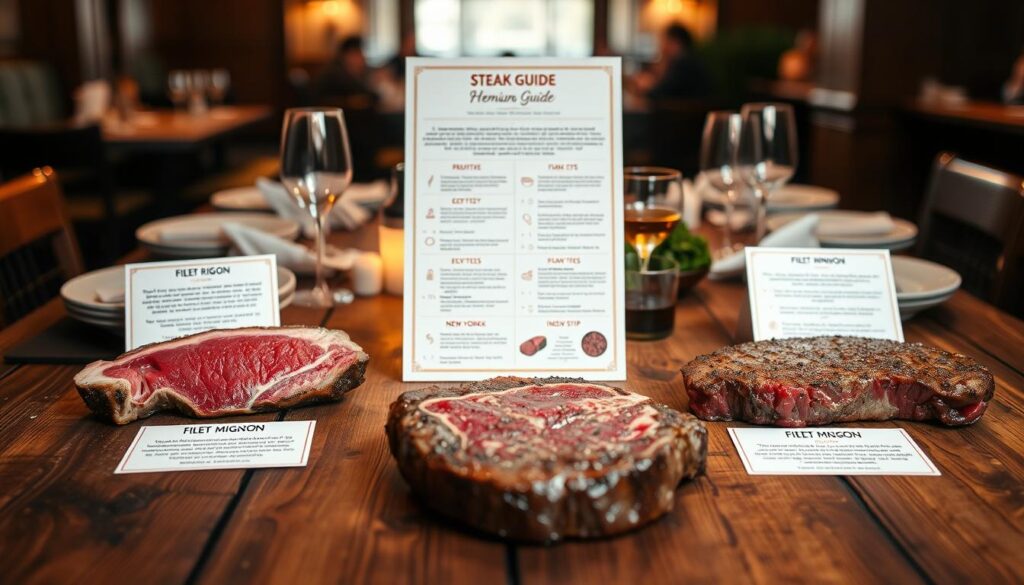
Finding the best cut of steak on a menu can be tough. Learning to order top steak cuts takes confidence and some insider tips. Whether you’re at a fancy steakhouse or a local spot, knowing how to ask for what you want is important.
Here are key tips for picking the perfect steak:
- Ask about the restaurant’s specialty cuts
- Inquire about the meat’s origin and grading
- Discuss preferred cooking temperature
- Request recommendations from experienced servers
How you order can really change your meal. Professional servers are usually happy to help you pick the best steak. Feel free to ask all about the top steak cuts they offer.
| Ordering Tip | What to Ask |
|---|---|
| Meat Quality | USDA grade, farm source, aging process |
| Cooking Preference | Recommended temperatures, chef’s suggestions |
| Cut Selection | Ribeye, filet mignon, New York strip details |
Getting the best steak means talking to the chef and server. They like it when you show real interest in their food. By asking smart questions, you’ll make your meal better and show respect for the restaurant’s skills.
Understanding Steak Pricing and Value
Exploring the world of premium meat cuts means knowing how price and quality connect. Restaurants and steakhouses offer a variety of high-quality steaks at different prices. It’s important for diners to make smart choices.
Price vs Quality Analysis
Just because a steak costs more doesn’t mean it tastes better. The price of premium meat cuts depends on several things:
- Beef grade (USDA Prime, Choice, Select)
- Marbling intensity
- Cut complexity
- Source and breeding method
Seasonal Considerations
Steak prices change throughout the year. Certain times of the year affect the availability and cost of high-quality steaks:
| Season | Price Impact | Availability |
|---|---|---|
| Summer | Higher demand | Peak grilling season |
| Winter | Potential discounts | Lower restaurant traffic |
| Holiday periods | Premium pricing | Special cuts featured |
Special Occasion Selections
When picking a steak for a special event, keep these tips in mind:
- Choose rare cuts like Wagyu or dry-aged steaks
- Prioritize quality over quantity
- Consult with restaurant staff for recommendations
- Budget for a premium experience
Knowing about steak pricing helps you make better dining choices. This way, you can enjoy a great meal without breaking the bank.
Common Steak Cooking Mistakes to Avoid
Cooking the finest steak varieties is an art that needs skill and focus. Even those who cook often can make mistakes that ruin the steak’s quality.
Knowing the common mistakes helps you cook a perfect steak every time. Here are the main errors to steer clear of:
- Skipping meat temperature preparation
- Using the wrong cooking surface
- Overcrowding the cooking pan
- Cutting into the steak immediately after cooking
- Neglecting proper seasoning techniques
Managing the temperature is key when cooking top-rated steakhouse cuts. Room temperature meat cooks more evenly and avoids tough, dry steaks.
| Mistake | Consequence | Solution |
|---|---|---|
| Cold meat | Uneven cooking | Let steak rest at room temperature 30-45 minutes |
| High heat | Burnt exterior | Use medium-high heat for perfect sear |
| No resting period | Dry meat | Rest steak 5-10 minutes before cutting |
Professional chefs suggest using cast iron skillets or heavy-bottomed pans for the best steak results. Investing in quality cooking tools can improve your steak cooking skills.
When eating out, tell the restaurant how you like your steak. Restaurants that specialize in steak are usually happy to make it to your liking.
Conclusion
Exploring exclusive restaurant steaks is more than just eating. It’s an art that mixes cooking skill with personal taste. Each cut, from the rich Ribeye to the tender Filet Mignon, has its own story.
Learning about gourmet steak dishes means knowing about different cuts, cooking ways, and temperatures. This knowledge lets you choose the best steaks, making your dining better.
Finding the perfect steak is a personal journey. You might love a classic New York Strip or premium Wagyu beef. Your taste is the best guide. Try new cuts, cooking methods, and push your cooking limits.
With knowledge on steak, you’re set to make any meal special. Your new skills will impress friends and open up new flavors at your favorite steakhouse.
